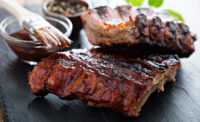With barbecue, meal prep counts as much as flavor. As the perfect canvas for flavor and health trends, barbecue offers something for even the pickiest of eaters.
“The top dishes with barbecue mentions are barbecue chicken pizza, barbecue chicken sandwich, barbecue chicken, pork ribs, then chicken wings apps, in that order, according to Technomic’s Ignite menu data,” says Lizzy Freier, managing editor at Technomic, a Winsight Company, based in Chicago.
The fastest-growing preparations paired with barbecue mentions are fire-roasted (+50.0 percent year over year), rotisserie (+26.5 percent year over year) and raw (+18.5 percent year over year), according to Technomic, says Freier.
Of the five barbecue dishes with the greatest purchase intent scores, “preparation descriptors are a common theme, with phrases including ‘roasted to fall-off-the-bone tenderness,’ ‘hand-crafted,’ ‘serve it hot off the grill, searing in the flavor,’ ‘slow braised’ and ‘premium, thinly sliced tender and juicy’ all in descriptors of the top five,” Freier says.
The top global ingredients paired with barbecue are (in order) jalapeno, cilantro, teriyaki sauce, chipotle and Parmesan, according to Technomic’s Ignite.
“But there are a number of fast-growing global ingredients paired with barbecue as well — mentions of ancho, for example, are up 10.5 percent year over year with barbecue, and mentions of Thai chili pepper are up 10.2 percent,” Freier says. Barbecue curry, North African flavor infusions in barbecue sauce, toban djan (fermented Chinese chili bean paste) in barbecue dishes and Korean barbecue (bulgogi), are also trending, notes Freier.
“Consumers are looking to ‘travel’ through their mealtime experiences, but exploration still needs to be approachable, particularly when it comes to new flavors” such as carne asada and barbacoa, says Eric Watkins, director of product management at Verde Farms, in Woburn, Mass.
Particularly at barbecue restaurants. “Rather, the opportunity may exist outside that segment with operators that want to get into barbecue but don’t have the space or labor to pull it off,” says Maeve Webster, president of Menu Matters, in Arlington, Vt. “Barbecue restaurants more often than not pride themselves on their skill at doing that one type of preparation, so I’m not sure they would bring in a prepared product.”
Other restaurants, though, “could capitalize on barbecue’s popularity but offer something unique that fits into their non-barbecue-focused menu and creates a unique competitive point of differentiation,” says Webster.
Resurgence of regional barbecue
For most operators, it will be a challenge to just reopen and get back into the groove. “I’m not sure many of these operators, with so many of them being independents, are necessarily experimenting with new items so much as navigating the new reality between reopening, more off-premise and trying to make reduced capacity work,” says Webster. “Many of their dishes work well for off-premise but others — like pulled-pork sandwiches — can get soggy fast, so my guess is many are looking at new ways to package and present these dishes to ensure the quality is as great as possible by the time the patron is ready to eat.”
Sides, appetizers and condiments provide variety to the main menu, without changing the core offerings, says Webster.
“With domestic travel likely dominating travel behavior for the next 12 months, I think we’re going to see a real resurgence — again — of regional barbecue,” says Webster. “We’ve seen this come and go, but I think it will again become a big area for both innovation and uniqueness.”
Americans continue to have a love affair with spicy — as in hot — flavor profiles which remain very popular.
Balance between health and innovation
Barbecue also has a new attribute today: healthy.
“Health and wellness has only continued to rise as a trend among all protein offerings, including barbecue,” says Watkins. “As barbecue and grilling season approaches, modern consumers —especially Millennials and those fitting dietary profiles like flexitarian, keto and paleo — are on the lookout for products that are better for their health, as well as for the environment and animals.”
With growth in the DIY barbecue/grilling space, there is an increasing opportunity for product formats that can strike a balance between innovative at-home conveniences and an accessible way to explore the novelty of global flavors, says Watkins.
“I think where barbecue operators are going to have to take a stand is the presence of meatless options,” Webster says. “I don’t think barbecue operators have to offer any of the plant-based — whether natural or hyper-processed — items, so I think an operator needs to think about what role these options may have in their operation and whether they are a fit based on strategy and brand position.”
Opportunities for new offerings
Sauce and marinade sections — including globally inspired product innovations — of the grocery store are certainly expanding with new international and culturally inspired offerings, “but this kind of penetration isn’t happening at the same rate in meal solutions or RTC (ready-to-cook) spaces, presenting a sizable opportunity for manufacturers to draw in new customers with attractive and innovative flavors and formats,” Watkins says.
“Barbecue mainstays are items such as ribs, brisket or pulled proteins like pork and chicken,” Watkins says. “Over the last several years in retail ready-to-eat (RTE) especially, items like burnt ends, beef ribs, pork carnitas and smoked pork chops have begun to emerge on shelf. Beef items are not as prevalent in RTE meal solutions due primarily to the cost of beef relative to lower-cost proteins such as pork and chicken.”
Packaging trends also dictate new convenience innovations for the consumer to make food storage and meal prep as smooth and mess-free as possible, Watkins says.
For in-home use, instant pots and air fryers have expanded kitchen capabilities and efficiencies, and manufacturers have responded by launching products designed especially for those appliances, as well as by adjusting cooking instructions on existing products to suit those preparation methods, Watkins says.
“In the backyard, new cooking tools and methods are really taking off with DIY pitmasters,” Watkins says.
“The gaining popularity of pellet grills and ceramic grills offer a lot of versatility to smoke, grill and sear in the same unit.”
Also rising in popularity is the sous vide cooking method, which allows consumers to transfer meat that’s been cooked low and slow to tender perfection to a heated cooking surface like a grill or cast-iron skillet for a quick sear before enjoying in minutes, says Watkins.








